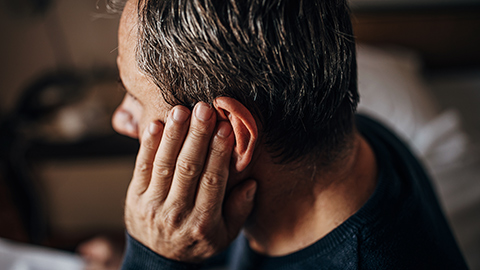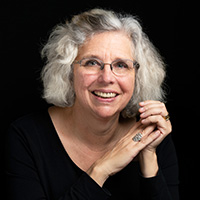
A client has frequent ear infections, including now while he’s awaiting a prescription of antibiotics. He wants massage for his neck and shoulders. He has a history of a ruptured eardrum and several surgeries. And by the way, he’s a surfer.
Usually, we say that massage and acute infections don’t really go together. But this client seems fine—he gets these infections often and they don’t impact his daily living.
Is that a go-ahead for massage? Maybe, maybe not.
Resources: 
Pocket Pathology: /abmp-pocket-pathology-app
Ear: Anatomy, Facts & Function (no date) Cleveland Clinic. Available at: https://my.clevelandclinic.org/health/body/24048-ear (Accessed: 19 January 2023).
Ear anatomy: MedlinePlus Medical Encyclopedia Image (no date). Available at: https://medlineplus.gov/ency/imagepages/1092.htm (Accessed: 19 January 2023).
Landefeld, K. et al. (2022) Surfer’s Ear, StatPearls [Internet]. StatPearls Publishing. Available at: https://www.ncbi.nlm.nih.gov/books/NBK534874/ (Accessed: 19 January 2023).
Ruptured eardrum (perforated eardrum) - Symptoms and causes - Mayo Clinic (no date). Available at: https://www.mayoclinic.org/diseases-conditions/ruptured-eardrum/symptoms-causes/syc-20351879 (Accessed: 19 January 2023).
Swimmer’s Ear (no date). Available at: https://www.hopkinsmedicine.org/health/conditions-and-diseases/swimmers-ear (Accessed: 20 January 2023).
‘What is Surfer’s Ear? | SurfEars’ (2018), 18 May. Available at: https://surfears.com/surfers-ear/ (Accessed: 19 January 2023).


0:00:01.4 Ruth Werner: Hello, I Have a Client Who listeners, Ruth Werner here, and I'm so excited to let you know that my library of online self-paced continuing education courses has just expanded. I now have a two-hour ethics course called a doctor's note is not good enough, and what is better? This NCBTMB approved course goes into why a doctor's permission, or approval or even a prescription doesn't provide the legal or safety protection you might think it does. Then we look at how to start useful conversations with healthcare providers that will actually get us to safe and effective massage for our clients with complex conditions. Visit my website at ruthwerner.com for more information and to register for a doctor's note is not good enough, and what is better?
[music]
0:01:00.5 RW: Hi, and welcome to, I have a client who, pathology conversations with Ruth Werner, the podcast where I will discuss your real life stories about clients with conditions that are perplexing or confusing. I'm Ruth Werner, author of a massage therapist's Guide to pathology, and I have spent decades studying, writing about and teaching about where massage therapy intersects with diseases and conditions that might limit our client's health.
0:01:29.5 RW: We almost always have something good to offer even with our most challenged clients, but we need to figure out a way to do that safely, effectively and within our scope of practice, and sometimes as we have all learned, that is harder than it looks.
0:01:47.6 RW: Oh, my dear listeners. I have a great one for you today, it comes to us from a massage therapist in Australia who sent me this, and I won't try to do the accent. They said, "I have a client who is wanting a massage, with a neck and shoulder focus, but he currently has an ear infection, and I'm wondering about the appropriateness of treatment, he gets ear infections regularly, has ear discharge and has a doctor's appointment this afternoon to request more antibiotics, he says he feels fine otherwise and is used to them, he burst his eardrum years ago, and has had many surgeries to repair the last being 12 months ago. He is continuing with his normal activities of daily living and has no fever or fatigue, is any type of massage appropriate for him at the moment?"
0:02:39.0 RW: Well, I followed up with this person and I asked them if they knew whether this ear infection was Otitis Media or Otitis Externa, that just helps us to locate where the infections develop, and they replied with this. "Sorry, Ruth, I'm unsure whether it is externa or media, I know that when he gets water in his ear, this increases the chances, and he's a surfer, so I think this might impact the frequency of his infections."
0:03:10.3 RW: Aha. So this client gets frequent ear infections, and he's had a ruptured eardrum and several surgeries, and he's a surfer. Well, we all know the drill here, I am not a doctor, I can't diagnose, but just out of interest, I looked up a condition called surfer's ear, and it is possible that this is what our client is dealing with, or maybe it's swimmer's ear, which is a little bit different. So in our episode today, I'm gonna take a small detour down the rabbit hole of ruptured eardrums, and then I will share some information about swimmer's ear and surfer's ear, and then we will actually get back to this therapist question about whether massage is safe for a person with this kind of ear infection.
0:04:00.1 RW: But before we do all of that, let's just take a very quick stroll through our ear anatomy, shall we? And I do have a picture in the show notes if you'd like to follow along. So do me a favor if you would and just grab your ear, and the part that you have grabbed, the part that you can turn and twist and stretch is your pinna. And it's made of fibrocartilage, it's dense, it's flexible, when we move it, it pretty much snaps back into shape. The fancy name for the ear hole is the external auditory meatus, and that is what goes into the head for about an inch, forming what we call the outer part of the ear. That auditory canal, ends at the tympanic membrane or eardrum, which is a dime-sized transparent grayish membrane, and here's something interesting I learned as I gathered information for this episode, the size of a newborn babies eardrum is the same size as an adult's eardrum, that just made me go huh.
0:05:03.3 RW: On the other side of the eardrum, we find the middle ear, which is the space where those teeny tiny bones, the middle ear ossicles, which are called the malleus, the Incus, and the stapes. Or you may have learned them as the hammer, the anvil and the stirrup... That's where they live. The malleus attaches directly to the inner side of the eardrum, so when that membrane vibrates from sound waves, those vibrations are picked up by the little bones that then carry them to specialized nerve endings in the inner ear, and that's where the nerve signals are sent to the brain to be interpreted as sound.
0:05:42.1 RW: Personally, I am absolutely fascinated by the inner ear, that's the part with the cochlea that looks like a snail shell and the semi-circular canals that are at extremely precise angles. We have two different century activities happening in there, one for sound, as we just said, and one for balance and orientation to the horizon. But today's story does not take us here, so let's back out of the inner ear and into the middle ear, and now to the eardrum. When I was a kid, I used to get a lot of ear infections and they hurt like crazy, and somewhere along the line I had heard the term burst eardrum, and I had this vision in my head of this explosion followed by permanent deafness and yes, the membrane can tear, that's eardrum rupture, but it does not usually lead to permanent deafness. And I was so relieved, even as an adult to learn that ruptured eardrums heal.
0:06:44.4 RW: So what can cause a tear in the tympanic membrane? Well, a good way to start is an infection in the middle ear that is otitis media, this can cause pressure to build up as fluid and puss accumulates and pushes on that delicate tissue. But eardrums can also be injured by barotrauma, that's a rapid change in external pressure, we might see this with scuba diving or deep snorkeling or if there happens to already be a lot of fluid present, because of congested sinuses, then changing altitude in an airplane or even a vehicle can cause barotrauma.
0:07:22.0 RW: Also acoustic trauma, that is being cause by explosions, or gunshots can damage the eardrum and foreign objects like cotton swabs can do it, and so can severe head trauma. The good news is, as we've said, this damage isn't permanent and most of the time, eardrums heal perfectly well within a few weeks. Sometimes it needs surgical intervention and maybe the insertion of a patch to help that along. Of course, having a ruptured eardrum means it's easier for infectious agents to get into that middle ear, which means Otitis Media may continue to be a problem. Alright, so that's a quick fly-by of ruptured eardrums, and we know this client has a history of this along with repeated surgeries. Hold on to that thought.
0:08:10.9 RW: Now, let's talk about a really common thing that happens among people who are frequently exposed to cold wind and cold water, and that's a condition called Surfer's ear, although it doesn't just effect surfers, open water swimmers, kayakers, sailors, anyone frequently exposed to cold air and cold water in the ear may develop this problem. Surfer's ear is a situation where maybe because of repeated exposure to cold, the bony tissue that lines the auditory canal begins to grow bone spurs, and this excess bony growth is called exostoses. And the formal name for surfer's ear is External Auditory Canal Exostoses. 'Ex' for outside 'osto' for bone and 'Oses' for pathologic condition.
0:09:05.4 RW: And once those bones grow, they stay... If the person stops whatever activity triggered the process, they might stop growing, but sometimes they continue to grow and they definitely don't just go away. I read a few resources about surfer's ear and they all proposed essentially the same process for how this develops cold air and cold water regularly swirls around in the ear canal, the body responds by trying to warm the affected area and bringing blood flow to that area. This triggers bone-producing cells, those Osteoblasts in the ear canal, and this causes the bone around the ear to develop bone spurs. And when we talk about cold water or cold air, we mean anything that's under 66 degrees Fahrenheit.
0:09:55.6 RW: Now, all of this happens slowly over a number of years, and you can see where this might lead, bone spurs inside the ear canal can make it harder for water that gets in to get out, they can raise the risk for repeated ear infections. For impacted Cerumen, that's the fancy word for earwax and for hearing loss. Otorrhea refers to seepage from the ear. Drainage, this could be related to trapped water, but it might also be the remnants of chronic and repeated infections. And this problem can contribute to eardrum rupture. A risk of inner-ear infections and Mastoiditis, that's a situation where infectious agents set up shop in the trabecular bone of the mastoid process, it's a bone infection and it's really hard to fight.
0:10:44.6 RW: In short, surfer's ear can be a painful and permanent problem, and the treatment involved surgery to shave or drill or chisel off those bone spurs, sounds delightful? And if the person returns to cold water surfing or other activities, then the whole thing may start over again. Swimmer's ear is quite different. This is a colloquial name for chronic repeating infections of the outer ear, that is anywhere from the pinna up to the eardrum, this is otitis externa. It's related to swimming in polluted water, having irritation in the ear canal from a cotton swab or other objects, dry skin in the ear canal, or any other situation that can damage the skin and open the door to infection.
0:11:31.9 RW: And all of this results in redness, maybe some itching in the ear, and lots of pain even from just gently touching the ear lobe, or the pinna. We might see draining puss, swollen lymph nodes in the neck and fever. And these go along with some symptoms that swimmer's ear and surfer's ear have in common. Specifically, this feeling of having the ears be stuffed or full and muffled hearing or hearing loss.
0:11:56.6 RW: From our contributors description, I'm sort of leaning away from thinking this is swimmer's ear, and leaning toward thinking about surfer's ear. Just for reference, here's that description again. My client wants a massage with a neck and shoulder focus, but he currently has an ear infection, he gets these regularly, he has ear discharge and a doctors appointment this afternoon to request more antibiotics. He says he feels fine otherwise, and he's used to this, he burst his eardrum years ago and has had many surgeries to repair, the last about a year ago. He continues with normal activities of daily living, he has no fever, no fatigue, when he gets water in his ear, this increases the chance of an infection and he's a surfer, so I think this might impact the frequency of his infections.
0:12:45.5 RW: So from this description, what do you think? Do you think surfer's ear and those bone spurs is a possibility? I'm just so curious to know about this client's history and what his surgeries have involved, but ultimately does it really matter? After all, he doesn't feel bad, he has no fever, he has no impact on his activities of daily living. Well, it does matter, or at least it might a little bit, because getting frequent and repeating infections is not ideal, and it would be great to encourage this client to get on top of this situation so he doesn't have to keep going back for more antibiotics.
0:13:25.7 RW: And of course being on long-term antibiotics carries its own set of possible problems. That might be a good question to ask by the way, is he having any negative effects related to his medications? But the rest of that discussion about whether it's surfer's ear or something else, that's really up to this client and his doctor, but in the meantime, here's what we know. He's doing his normal activities, he's not feverish or feeling sick, he'd like to receive massage with a neck and shoulder focus. My recommendation is that I think avoiding the area around his ears and the mastoid process and all that part of the neck, until his current infection is cleared up is a good idea.
0:14:11.8 RW: Because if he's dealing with bacteria or other cooties in his cervical or Occipital or mandibular lymph nodes, his body is doing some hard work to eradicate them and he doesn't need our interference. However, we know he's otherwise healthy and symptom-free, and so just avoiding the area around his ears and that part of his neck seems like an adequate accommodation. If however, our contributor happens to be educated in lymphatic drainage, I would be interested to hear if after his infection has cleared, that approach might impact his overall long-term ear health, I would just love to hear how this works out, so I will invite our colleague to send me some follow-up information. And if I hear anything, I will be sure to let you know.
0:15:05.6 RW: Hey everybody, thanks for listening to, I have a client who, pathology conversations with Ruth Werner, remember, you can send me your, I have a client who stories to, ihaveaclientwho@abmp.com. That's I Have a Client Who, all one word, all lower case at abmp dot com. I can't wait to see what you send me and I'll see you next time.